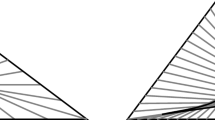Abstract
We construct a convex domain such that the second Neumann eigenfunction has an arbitrary number of isolated local maximum points on the boundary. This domain, which is close to a sector, is constructed by combining thin isosceles triangles. Then we study the shape of the second Neumann eigenfunction on isosceles triangles. In particular, we show that if the isosceles triangle is subequilateral, then the second Neumann eigenvalue is simple and the associated eigenfunction has exactly two maximum points which are located at two corners.
Similar content being viewed by others
References
Atar, R., Burdzy, K.: On Neumann eigenfunctions in lip domains. J. Am. Math. Soc. 17, 243–265 (2004)
Ashbaugh, M., Levine, H.: Inequalities for the Dirichlet and Neumann eigenvalues of the Laplacian for domains on spheres, Journées “Equations aux Dérivées Partielles” (Saint-Jean-de-Monts, 1997), Exp. No. I, École Polytech., Palaiseau (1997).
Courant, R., Hilbert, D.: Methods of mathematical physics, vol. I. Interscience Publishers Inc., New York (1953)
Burdzy, K.: The hot spots problem in planar domains with one hole. J. Duke Math. 129, 481–502 (2005)
Bañuelos, R., Burdzy, K.: On the “hot spots” conjecture of. J. Rauch. J. Funct. Anal. 164, 1–33 (1999)
Bass, R., Burdzy, K.: Fiber Brownian motion and the “ hot spots” problem. J. Duke Math. 105, 25–58 (2000)
Burdzy, K., Werner, W.: A counterexample to the “hot spots” conjecture. Ann. Math. 149, 309–317 (1999)
Casten, R., Holland, C.: Instability results for reaction diffusion equations with Neumann boundary conditions. J. Differ. Equ. 27, 266–273 (1978)
Gierer, A., Meinhardt, H.: A theory of biological pattern formation. Kybernetik (Berlin) 12, 30–39 (1972)
Grebenkov, D., Nguyen, B.: Geometric structure of Laplacian eigenfunctions. arXiv:1206.1278v1 (2012)
Hartman, P., Wintner, A.: On the local behavior of solutions of non-parabolic partial differential equations. Am. J. Math. 75, 449–476 (1953)
Helffer, B., Hoffmann-Ostenhof, M., Hoffmann-Ostenhof, T., Owen, M.P.: Nodal sets for groundstates of Schrödinger operators with zero magnetic field in non-simply connected domains. Commum. Math. Phys. 202, 629–649 (1999)
Jerison, D., Nadirashvili, N.: The “hot spots” conjecture for domains with two axes of symmetry. J. Am. Math. Soc 13, 741–772 (2000)
Kawohl, B.: Rearrangements and convexity of level sets in PDE, Lecture Notes in Mathematics, vol. 1150. Springer, Berlin (1985)
Laugesen, R., Siudeja, B.: Minimizing Neumann fundamental tones of triangles: an optimal Poincaré inequality. J. Differ. Equ. 249, 118–135 (2010)
Matano, H.: Asymptotic behavior and stability of solutions of semilinear diffusion equations. Publ. Res. Inst. Math. Sci. 15, 401–454 (1979)
McCartin, B.: Eigenstructure of the equilateral triangle. II. The Neumann problem. Math. Probl. Eng. 8, 517–539 (2002)
Miyamoto, Y.: An instability criterion for activator-inhibitor systems in a two-dimensional ball. J. Differ. Equ. 229, 494–508 (2006)
Miyamoto, Y.: An instability criterion for activator-inhibitor systems in a two-dimensional ball II. J. Differ. Equ. 239, 61–71 (2007)
Miyamoto, Y.: On the shape of the stable patterns for activator-inhibitor systems in two-dimensional domains. Q. Appl. Math. 65, 357–374 (2007)
Miyamoto, Y.: The “hot spots” conjecture for a certain class of planar convex domains. J. Math. Phys. 50, 103530 (2009)
Miyamoto, Y.: Global bifurcation and stable two-phase separation for a phase field model in a disk. Discret. Contin. Dyn. Syst. 30, 791–806 (2011)
Pascu, M.: Scaling coupling of reflecting Brownian motions and the hot spots problem. Trans. Am. Math. Soc. 354, 4681–4702 (2002)
Payne, L.: On two conjectures in the fixed membrane eigenvalue problem. Z. Angew. Math. Phys. 24, 721–729 (1973)
Rauch, J.: Five problems: an introduction to the qualitative theory of partial differential equations. Partial Differential Equations and Related Topics (Program, Tulane Univ., New Orleans, La., 1974). Lecture Notes in Mathematics, vol. 446, pp. 355–369. Springer, Berlin (1975).
Acknowledgments
The author thanks anonymous referees for the careful reading of the manuscript and comments pointing out that the proofs of Lemmas 3.2 and 3.5 of the previous version of the manuscript were imperfect.
Author information
Authors and Affiliations
Corresponding author
Additional information
This work was partially supported by Grant-in-Aid for Young Scientists (B) (Subject No. 21740116).
About this article
Cite this article
Miyamoto, Y. A planar convex domain with many isolated “ hot spots” on the boundary. Japan J. Indust. Appl. Math. 30, 145–164 (2013). https://doi.org/10.1007/s13160-012-0091-z
Received:
Revised:
Published:
Issue Date:
DOI: https://doi.org/10.1007/s13160-012-0091-z




